Affiliate links on Android Authority may earn us a commission. Learn more.
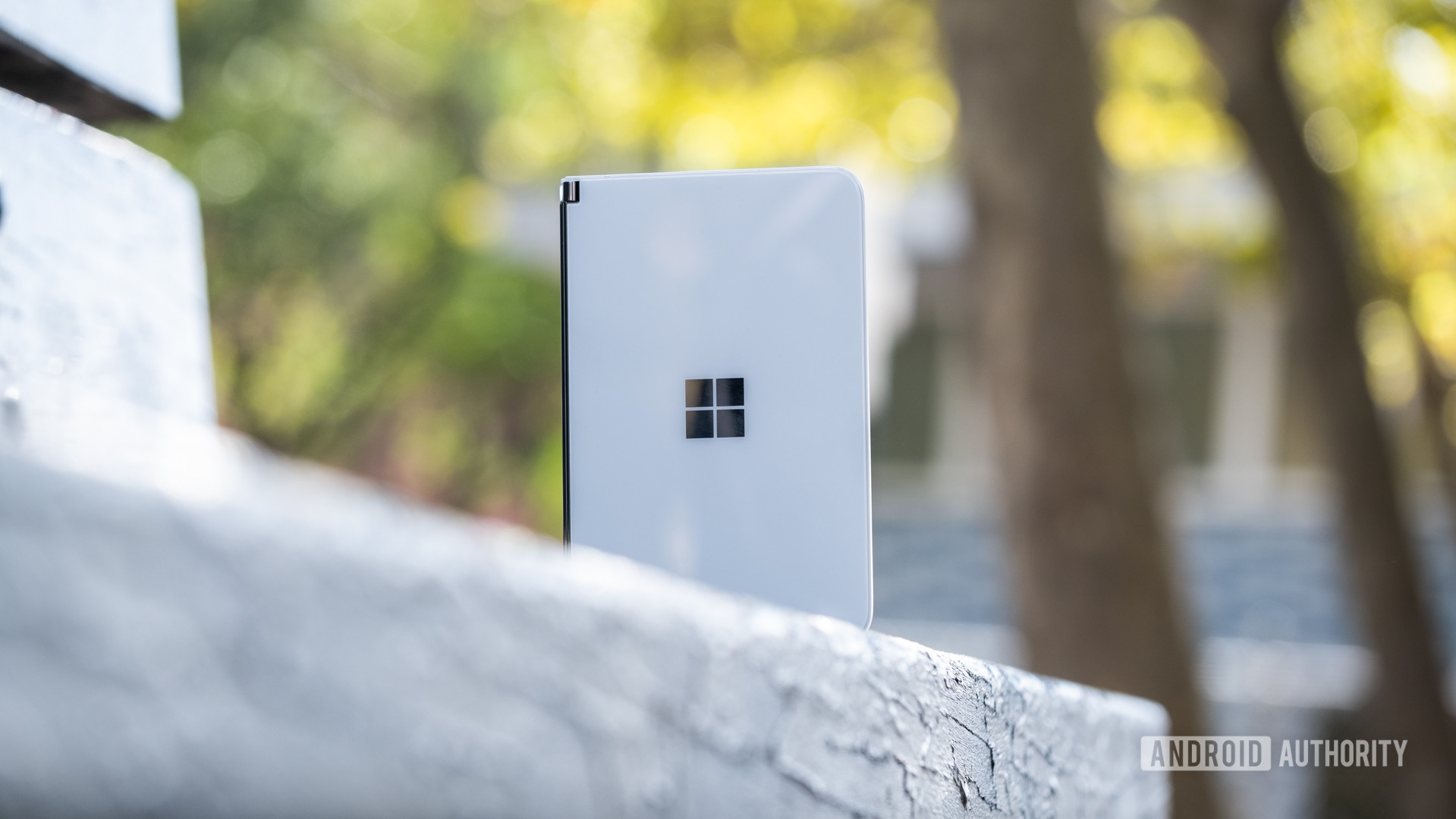
Microsoft Surface Duo
What we like
What we don't like
Our scores
Microsoft Surface Duo
Microsoft’s new “foldable” phone — the Surface Duo — is certainly different. While most of the foldable market has been defined by flexible devices that can seamlessly transition from small to big or vice versa, Microsoft believes in breaking your focus into two distinct windows.
The Surface Duo is a dual-screen device more than a foldable one, though it does fold almost perfectly in half when closed, leaving a clean booklet of hardware that is an impressive feat of engineering.
But what are the use cases for a dual-screen device? Are two separate displays as useful as one expandable one? And, more importantly, was Microsoft able to nail the smartphone nearly four years after the death of Windows Phone?
Find out in Android Authority’s Microsoft Surface Duo review.
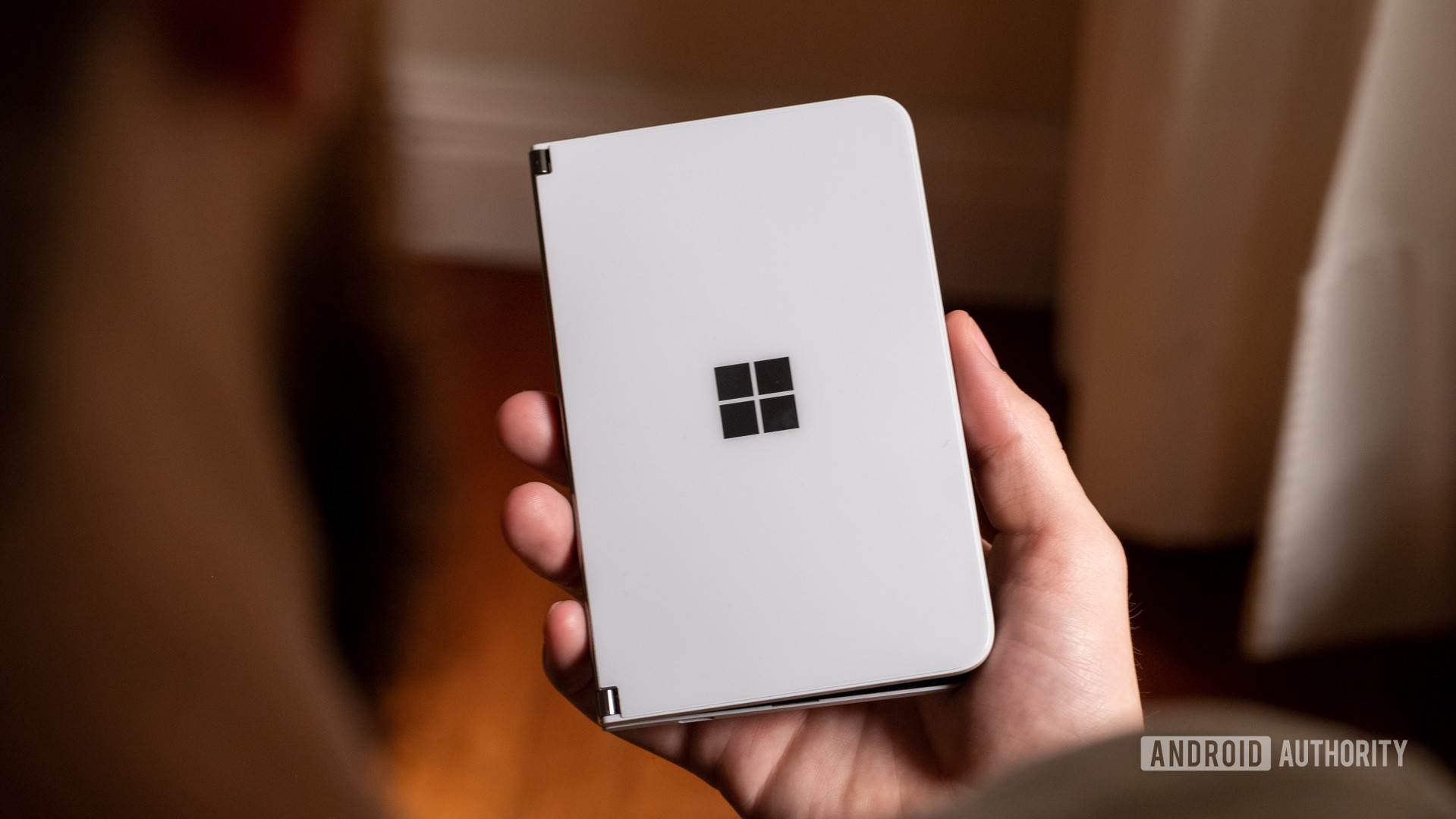
Design
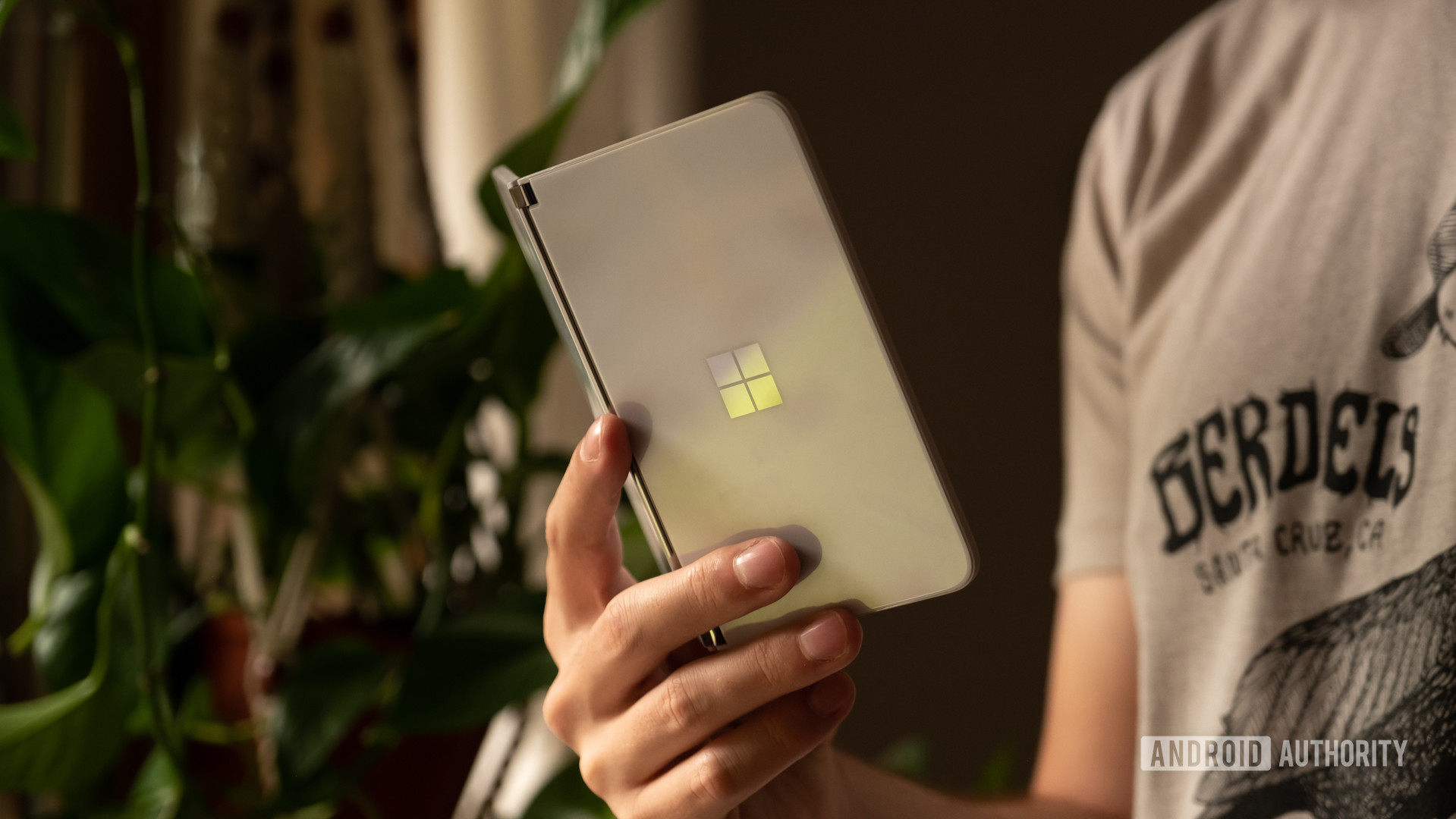
- Open: 145.2 x 186.9 x 4.8mm
- Closed: 145.2 x 93.3 x 9.9mm
- 250g
- Closing booklet design
- Fingerprint reader
- 360-degree hinge
The Microsoft Surface Duo’s design can be compared to a small booklet like a passport. Closed, it is only slightly thicker than the Samsung Galaxy Note 20 Ultra — 9.9mm compared to the Note 20 Ultra’s 8.1mm (which doesn’t consider the Note’s comically large camera bump.) Opened up, it’s about half as thick as closed at just 4.8mm. It’s barely thicker than the USB-C port used to charge the device.
That’s a pretty massive feat of engineering. While most phones aren’t inherently too thick for use, Microsoft wanted to make sure the Duo’s footprint was as close to a standard device as possible when closed. A primary criticism of foldable phones is the fact that they’re often about as thick as two phones, but the Surface Duo challenges that notion.
There are no screens on the outside of the Surface Duo, just white Gorilla Glass shells with the Microsoft logo printed on the front. The rim of the device is made of ceramic with a soft rubberized coating. It got fairly discolored during my time with the device, so don’t expect it to stay spotless. There is a USB-C port on the bottom of the right screen and a fingerprint reader on the right edge with the power button and a volume rocker sitting right above it.
Opened, you’ll find two 5.6-inch AMOLED displays. There are some pretty massive bezels surrounding both screens. An earpiece, camera, flash, and ambient light sensor are housed in the bezel of the right display. The left display has another ambient light sensor in the bezel and a speaker encased in the space between the bezel and rim.
Possibly the most interesting part of the Surface Duo is the hinge. Microsoft designed the Surface Duo’s hinge to allow for 360-degree movement of either display. This means the device can exist in multiple form factors, like laptop mode, tent mode, or single-screen mode. The hinge is smooth to turn and requires just the right amount of force to rotate. Microsoft said it had to make the wires connecting the two displays thinner than a human hair to achieve this. I’m impressed; it works incredibly well.
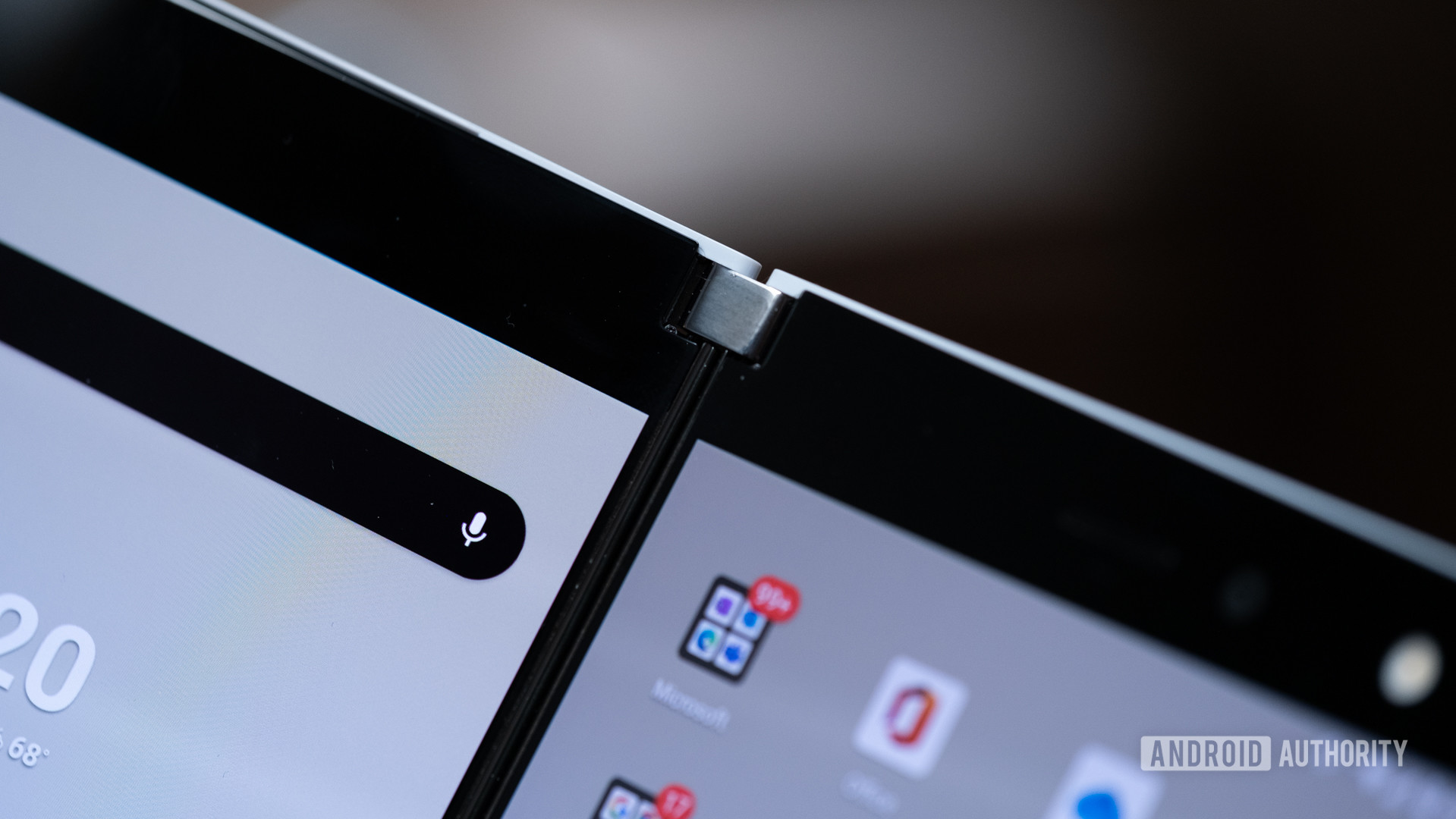
Overall, the design of the Surface Duo is elegant, but it still feels like a first-generation product. The hinge and overall thinness of the device are certainly something to behold, but I’d love to see more cameras and smaller bezels in future models.
Performance
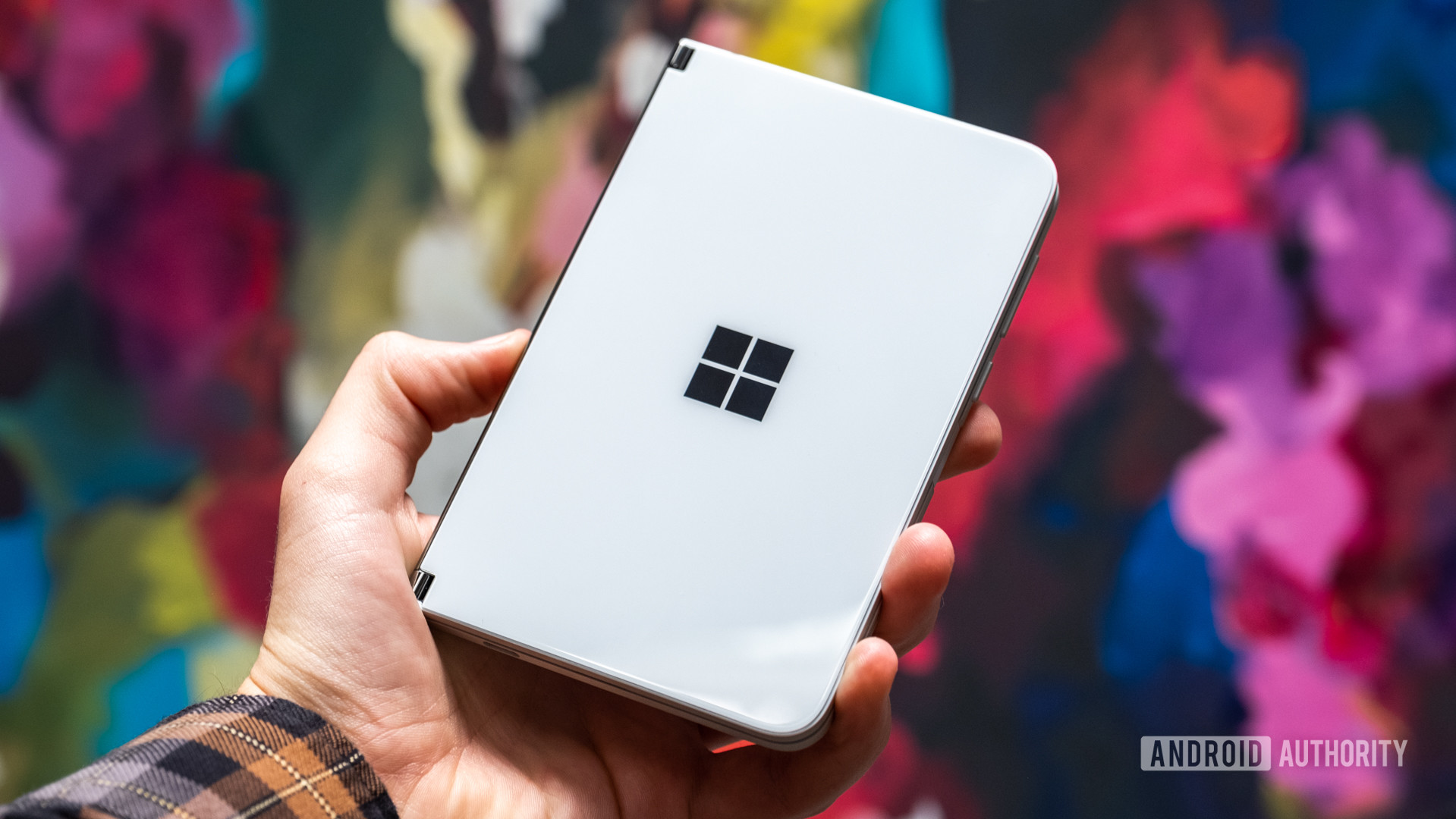
- Qualcomm Snapdragon 855
- 6GB RAM
- 128 or 256GB storage
- No expandable storage
The Microsoft Surface Duo runs the Qualcomm Snapdragon 855 processor, which is actually Qualcomm’s flagship chip from early 2019. Even so, that doesn’t mean it should be slow. The Snapdragon 855 is a great chip, and phones that use it are plenty fast.
Unfortunately, the Microsoft Surface Duo can be slow in a lot of circumstances. While there were times it managed to sustain a smooth level of performance, I was consistently frustrated by how much lag the device experienced. Animations would often stutter or take a few seconds to execute. I attribute this to software optimization much more so than hardware, though 6GB of RAM is certainly skirting the bare minimum for smooth performance in 2020.
The Surface Duo leaves a lot to be a desired where performance is concerned.
I should note that the device received a software update about halfway through the review period that did improve performance and stability. Even after the update, however, I encountered plenty of instances of sustained lag, freezing, and performance drops.
If you’re interested in benchmark scores, the Microsoft Surface Duo achieved some decent scores for a Snapdragon 855 device. In AnTuTu, it achieved a score of 412,006 vs the similarly-specced OnePlus 7 Pro’s 361,038. In 3DMark, it achieved a score of 5,517 and 5,032 vs the OnePlus 7 Pro’s 5,412 and 4,814, respectively. In Geekbench, it nabbed 3,491 and 10,393 vs the OnePlus 7 Pro’s 3,411 and 10,628 for the single-core and multi-core tests, respectively.
Even with respectable benchmark scores, Microsoft needs to put a lot more work into the Surface Duo before its performance is good enough to be sold as a consumer product. In its current state, it’s usable, but just barely. I found myself wanting to throw this device across the room in frustration every day.
Benchmarks help indicate theoretical performance, but the Surface Duo needs much more optimization before it’s able to achieve solid performance in the real world. Microsoft had originally slated the Surface Duo for a Holiday 2020 release before moving it up to September 10. The former would have given it some time to get the software working correctly. I can’t fathom why it would rush this out the door with the software in this state.
Displays

- Single: 5.6-inch, 1,800 x 1,350, 401PPI, 4:3 aspect ratio
- Opened: 8.1-inch, 2,700 x 1,800, 401PPI, 3:2 aspect ratio
- Max tested brightness: 455 nits
- AMOLED
Microsoft has always been a leader in unique display aspect ratios, and the Surface Duo is no different. In single-screen mode, you’re working with a 5.6-inch display with an aspect ratio of 4:3. This is a far cry from most smartphones, which come in between 19:9 and 21:9.
The 4:3 aspect ratio is likely a big reason why Microsoft Chief Product Officer Panos Panay refuses to call the Surface Duo a smartphone, instead insisting that it is a Surface. The wide display makes the device feel much more like a miniature computer in your hand. Shall we call it a… PDA?
When the Surface Duo is opened, its two screens together form an aspect ratio of 3:2. That’s the same ratio as many of the company’s laptops, including the Surface Book series. The 3:2 aspect ratio is great for working with multiple documents. This is likely a big reason why Microsoft chose this aspect ratio. It wants users to treat the Duo as a multi-app productivity machine.
The displays are AMOLED panels. Both look good, and I didn’t notice any major color issues between panels. These are 60Hz displays, so you’re not going to get any fancy high refresh rate action here.
It’s quite a bit easier to use the Surface Duo in a rotated, single-screen state. It’s still quite wide and feels different than a regular smartphone, but it makes it much easier to type on than when you’re holding it open. This is how I anticipate people will use the device in most cases.
The displays also support pen input and work with all current Surface pens. The Surface slim pen will magnetically attach to the device, but this isn’t out of design — it’s due to magnets in the Surface Duo’s displays. Unfortunately, you won’t get any sort of pen with the Surface Duo. You’ve got the phone, charger, bumper, and that’s it.
Software: Microsoft launcher, but in Alpha

- Microsoft Launcher
- Android 10
The Surface Duo is running Microsoft Launcher on top of Android 10. Unlike Android skins from most OEMs, this launcher is available on the Google Play Store, so you can experience a single-screened version of the launcher for yourself before you make any purchasing decisions.
Unlike single-screened devices though, Microsoft Launcher on the Surface Duo was made to accommodate the dual displays. This means this is the launcher you’re stuck with on the Surface Duo. If you try to install another launcher on the Surface Duo, uhh… this happens (see below). After I uninstalled Nova, the UI was still pretty messed up until I restarted the device.
By default, opening the app drawer on one display will slide the apps on your dock to the dock on the other display, and opening an app through that app drawer will open it on that display. You’re able to move an app on the current display to the other display by swiping up and dragging it across the hinge to the other display.
The Surface Duo also allows for spanning apps across both displays. This can be pretty useful. Microsoft Outlook will show your inbox on one display while an email preview pane is open on the other display, while Office will show your files on one display with a file open on the other display. And maybe most interestingly, Amazon’s Kindle app will show one page of a book on one display and the next page on the other, making it feel like a real book.
Unfortunately, the list of apps that are built for the Duo is extremely small. Ten of the 15 Duo-optimized apps are made by Microsoft, and there is little incentive for developers to build compatibility into their apps for this single device. Microsoft said it worked closely with Google while developing the Duo, but there are no Google apps optimized for spanning across both displays. For example, Gmail will recognize the device as a tablet but won’t recognize the hinge, so about 10% of the app is cut off in the center.
The current list of Duo-optimized apps is as follows:
- Adobe Acrobat Reader
- Amazon Kindle
- Jira Cloud
- Microsoft Swiftkey
- Microsoft Teams
- Microsoft To Do
- Microsoft Edge
- Microsoft Launcher
- Microsoft News
- Microsoft Office
- Microsoft OneDrive
- Microsoft OneNote
- Microsoft Outlook
- Mylio for Android
- Spotify
Microsoft also included a feature on the Duo called App Pairs, which allows you to launch two apps at the same time, with one on each display. An example would be launching a recipe app on one display while putting a grocery list on the other.
Microsoft launcher is fairly minimal. Unfortunately, it doesn’t offer many of the features that you’ll find on other Android devices. There’s no native screen recording on the device, and multitasking uses a vertical app selection method which is not very efficient. Swiping down on the notification tray doesn’t fill the entire screen, and the launcher just doesn’t feel finished.
Perhaps worse than the performance issues mentioned above is the sheer number of bugs from which the Surface Duo suffers. I found new bugs on this device nearly every day, and while Microsoft’s patch during the review period seemed to squash a couple of them, I’ve found new bugs after the update as well.
Here’s a select number of the bugs I encountered during my review:
- Unlocking the phone just sits on the unlock screen but doesn’t unlock
- The wallpaper disappears, or sometimes both displays just turn black
- Keyboards shift up the other screen or get rendered in the wrong place
- The camera interface doesn’t switch to the correct display and will hang and freeze the phone
- Single taps often register as a long press
- Apps sometimes get rendered as fully black interfaces when opening them from the notification tray
- Swiping up to go home often doesn’t work, switches you to the previous app, or throws the app you’re in on the other display
- Apps like Facebook Messenger span across both displays automatically and are hard to swipe away since the X button is rendered inside the hinge.
I’ve taken screenshots of as many bugs as possible during my review period. So here are a select few to show you what I mean.
While many of the Surface Duo’s bugs are more general, a number of them likely come from the fact that the Surface Duo thinks it’s a tablet. You can prove this by taking a screenshot while the phone is folded into the single-screen mode. When you take a screenshot, you still see the other display, even though it is physically off. This is annoying in its own right since you have to crop every screenshot, which leads to a lower resolution image, but even more frustrating is how that interaction deals with apps.
Android will dynamically scale interfaces and apps to fit whatever display it is rendered on, and Microsoft is intercepting the app rendering to force it onto each display individually. This breaks floating apps like Facebook’s Messenger Bubbles or Instagram stories, which don’t work correctly on this device. Messenger bubbles span across both displays and are hard to read, and getting rid of a bubble requires dropping the bubble somewhere in the hinge since the app doesn’t know there isn’t screen there.
I understand that creating new form factors is difficult, but there are so many bugs in the Surface Duo in its current state that consumers will likely end up quite frustrated — especially after spending $1,400. I would have liked to see Microsoft make the software experience on the Duo a lot more stable before releasing it to the public.
The big question: Are dual displays actually useful?
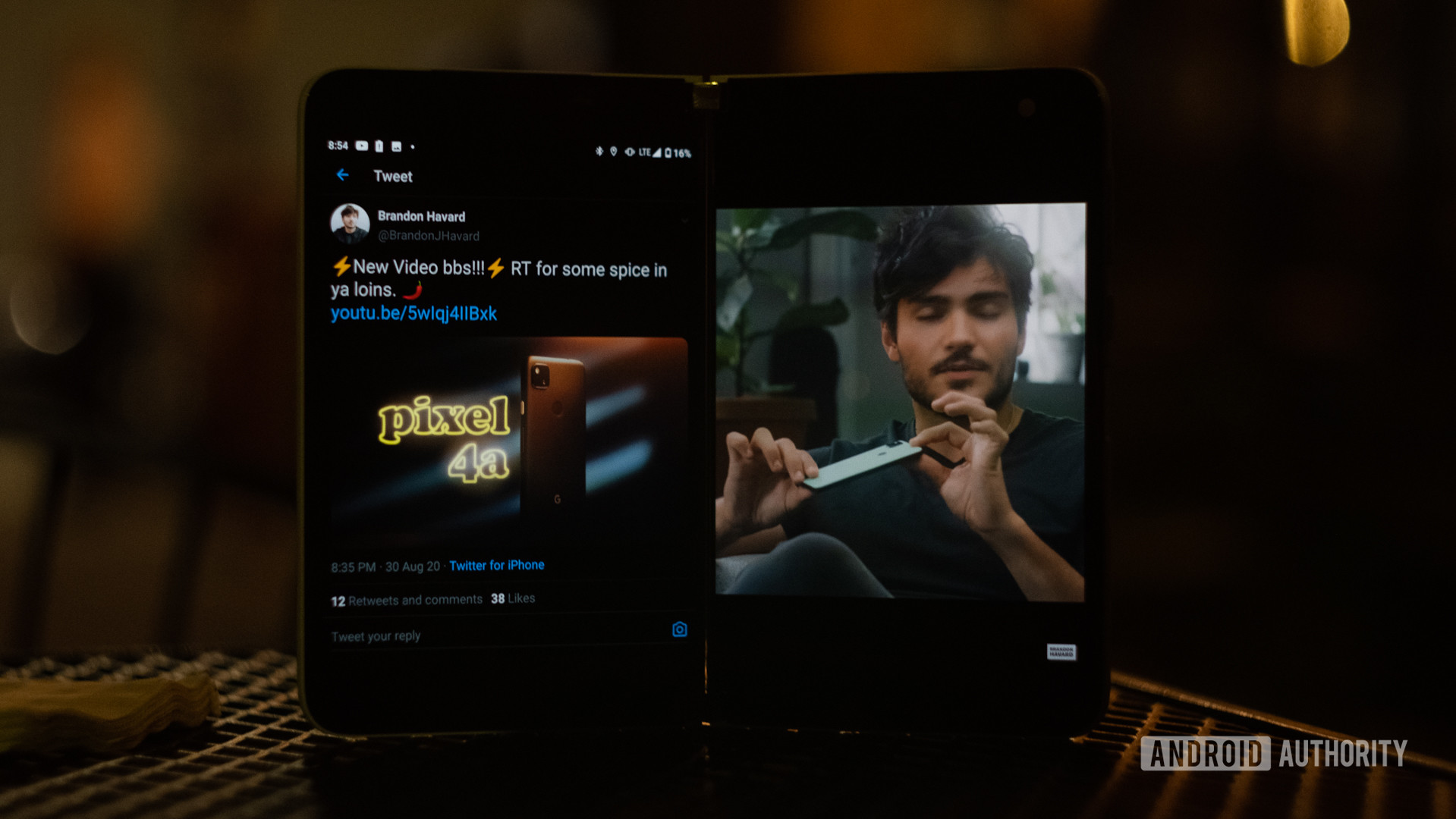
First, we should acknowledge that Microsoft is a company that loves to explore new form factors. Its Surface RT crashed and burned, but Microsoft continued to refine the product and eventually became a standard in 2-in-1 devices. The Microsoft Courier concept was supposed to redefine what it meant to be a mobile creative, before the idea was eventually shelved. Microsoft doesn’t always take the safe route, and there is value in that.
But over the last couple of weeks, I have thoroughly considered whether a dual-screen device is useful hundreds, if not thousands, of times. There have definitely been circumstances when having a second display was useful. For example, when I wanted to look up an Instagram page but I couldn’t remember the name, I opened Instagram on one display, found the handle on the other display, and copied it over. But instances like this are so infrequent, I’m not sure it’s worth all the trade-offs that come with having two displays.
I’ve experimented with dual-screen phones like the LG V60 and LG Velvet before, and I came to effectively the same conclusion. Having dual displays on a phone only seems useful in fringe circumstances, and needing to change the form factor of a device to accommodate for that doesn’t feel worth it. The Duo executes the dual-display design well by keeping the device so thin, but either way, I still feel the trade-offs aren’t worth the compromises.
I'm still looking for a good reason to have two displays.
One of my major annoyances with the Duo is the typing experience while the device is open. By default, Microsoft uses Swiftkey, in a right-handed orientation, which prioritizes swiping with your right thumb. Unfortunately, Swiftkey was incredibly buggy and bad at predicting what I was trying to swipe. I eventually switched to GBoard, but this meant I had to hold the device with my left hand and swipe with my right index finger. While this worked, it’s not fast and was just uncomfortable in general.
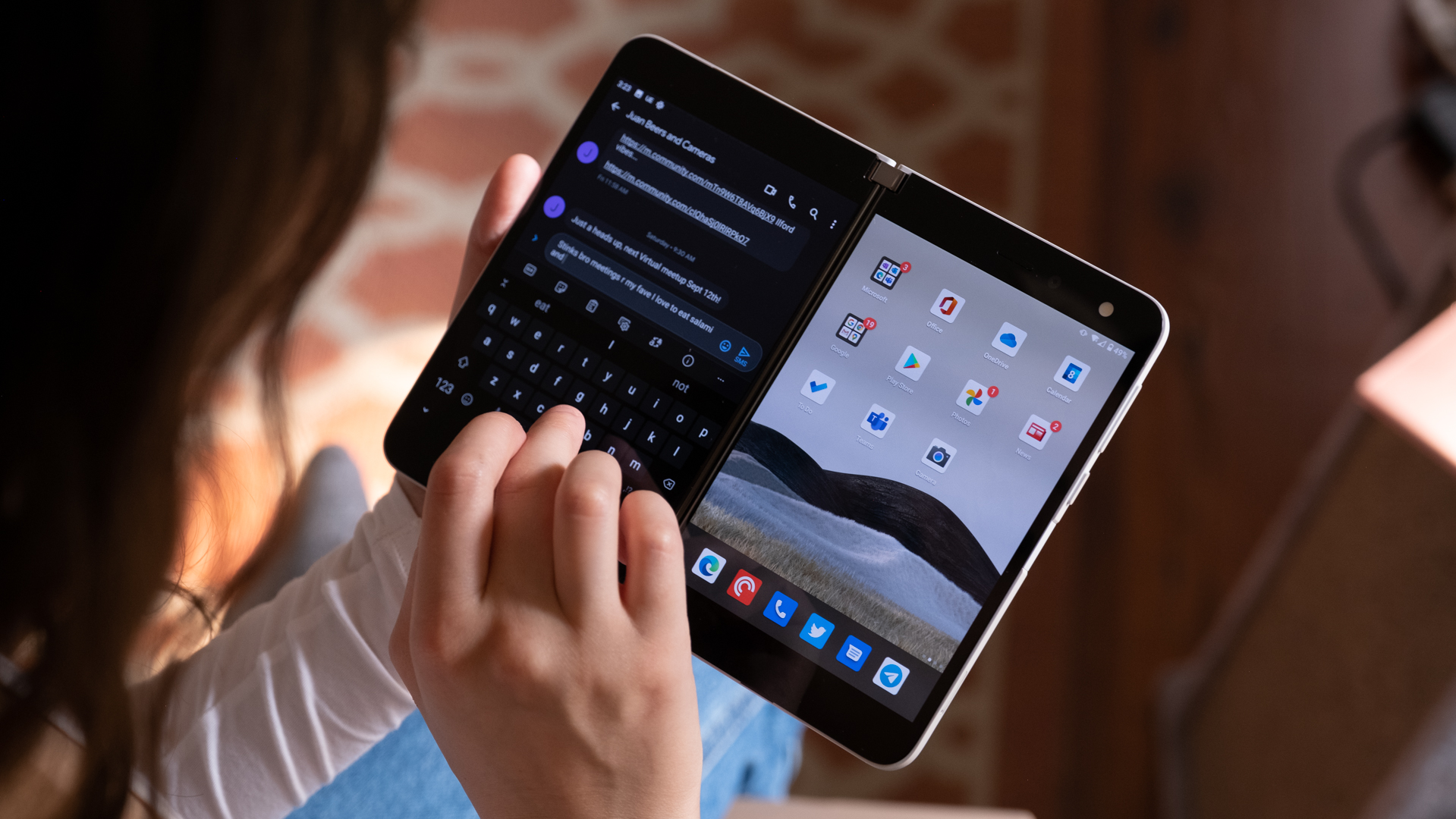
I can see how having reference information available on one display while you transfer it to your primary app is useful. If doing this is slow or uncomfortable, though, it takes away a lot of the benefit of that second display.
In contrast, a foldable phone like the Samsung Galaxy Z Fold 2 maintains a great typing experience while fully open. You can angle the Surface Duo like a laptop to have more space for typing, but it feels too cramped to use in this state.
In my opinion, there’s not much that a dual-display device can do that a foldable phone can’t do better. The big benefits of the dual-display device right now are having a solid, hard screen and pen input. Moreover, you can’t rotate a foldable phone 360-degrees if you want it to be smaller. But Samsung has improved ultrathin glass fairly quickly. Including a front display on something like the Galaxy Z Fold 2 removes the need to rotate 360-degrees.
While I can appreciate that Microsoft finally made the Courier tablet it wanted to make more than a decade ago, I don’t think we expected foldable technology to get as good as it has in the interim. That being said, it’s a bit difficult to evaluate the real value of the Surface Duo when it’s running effectively unfinished software.
Battery

- 3,577mAh battery
- 18W wired charging
- No wireless charging
When receiving the Surface Duo, I was worried that two large displays would eat up the conservatively-sized 3,577mAh battery. After all, a device like the Samsung Galaxy Z Fold 2 has a 4,500mAh battery. And while the battery life on the Surface Duo didn’t end up being fantastic, it wasn’t horrible either.
I often got about five and a half hours of screen-on time, which is about an hour less than average for me. This translated to me unplugging the device around 8 am and having the device die in the late evening, around 9pm or so. I would have liked to see a bigger battery in the Surface Duo, but Microsoft needed to keep the capacity on the conservative side to keep the device this thin.
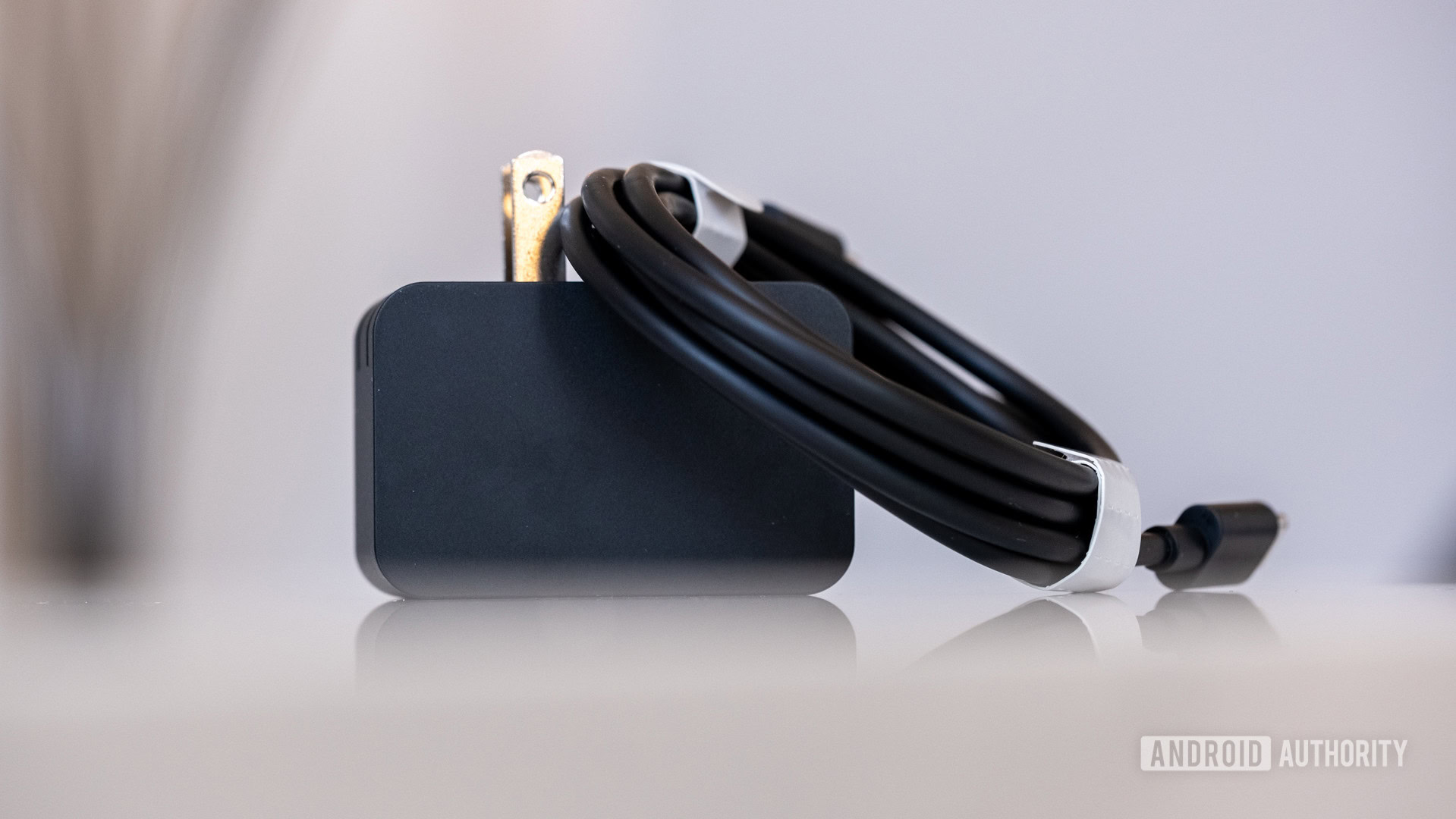
The Duo comes with an 18W charger, which will juice up the Duo fairly quickly, to 99% in a little over 90 minutes. Strangely though, the Duo took a ton of time to get from 99% to 100%, taking 127 minutes to hit full.
Microsoft didn’t include wireless charging in the Duo, which is a real shame in my opinion. The use of wireless charging is incredibly prevalent in my household, and it would be nice to set it on chargers like most of my other devices. Microsoft says it would have needed to add coils to both displays, which would have increased the thickness of the device by a considerable amount.
Camera: Surprisingly good for what it is
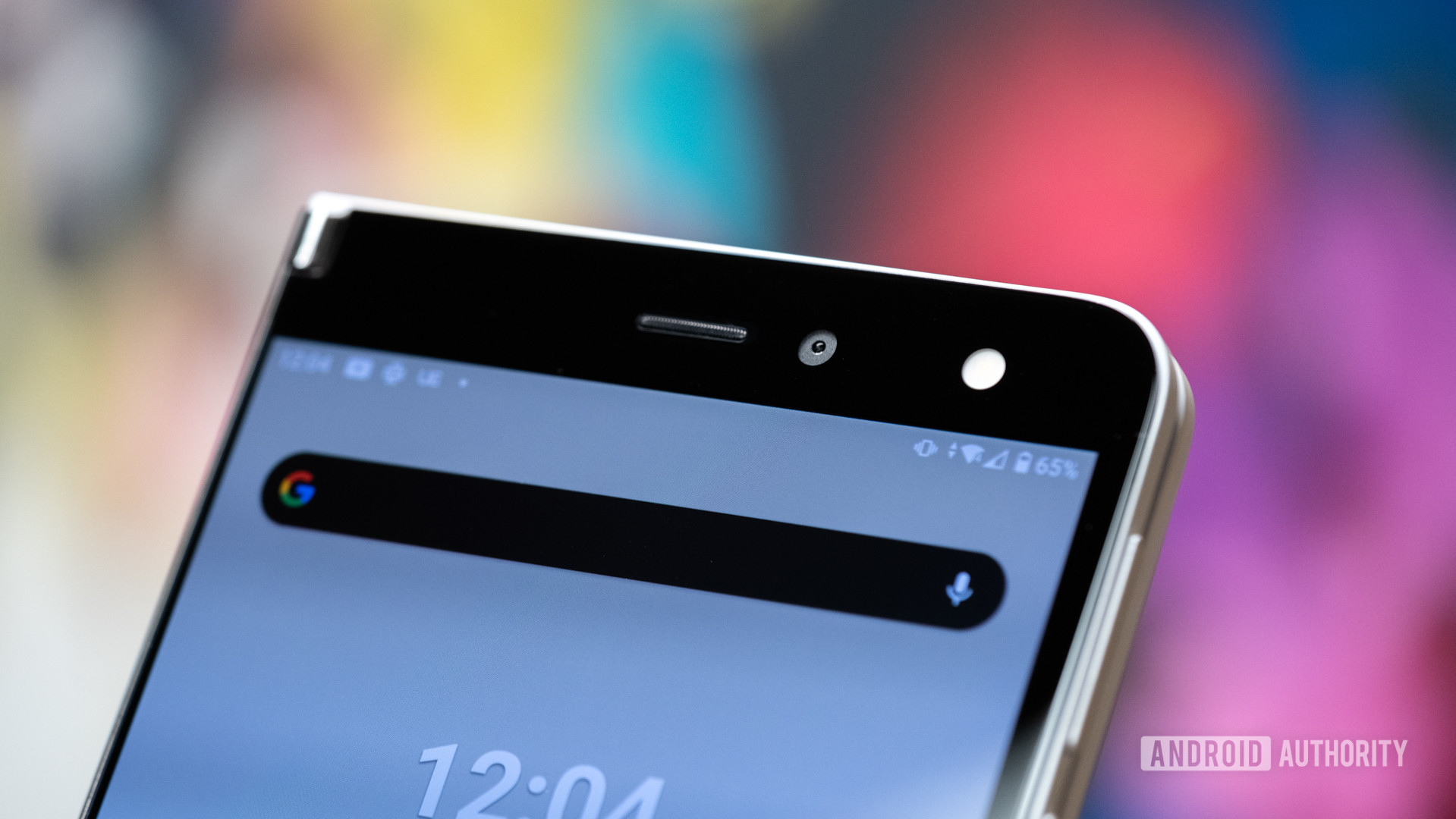
- Main: 11MP
- f/2.0 aperture
- Flash
- 1.0um pixel size
- 84-degree FOV
- Up to 4K @ 60fps video
The Microsoft Surface Duo only has one camera, an 11MP shooter on the inside right display. Microsoft explicitly stated that it didn’t see the camera as a priority, which means images don’t have much processing applied and there aren’t a lot of extra features. Most notably, there’s no night mode, which means anything taken in lower lighting environments can look pretty noisy.
In good light though, the Surface Duo takes some solid photos. Images aren’t oversaturated or oversharpened, and I’m a fan of the color. Many modern flagships will try to overdo dynamic range by making blacks look grey for no reason, but the Surface Duo does a good job of preserving detail while maintaining an appropriate level of contrast. Images feel true to life, and I like that.
Exposure doesn’t always meter correctly, though. Sometimes the highlights in an image get quite blown out if the camera doesn’t recognize highlights correctly. You can see in these two images that skin tones look quite similar, but the sky was not recognized correctly in one photo and was left super blown out.
The photo samples above have been compressed to optimize site performance. If you want to see the photos in their full resolution, check out the uncompressed images in this Google Drive photo here.
The Duo can also record video up to 4k 60fps. Video looks quite good with good dynamic range, though I did notice the white balance shifting a bit too frequently. 4k 60fps video also doesn’t playback smoothly on the Duo. It’s quite choppy when viewing it in the gallery, but that tracks with the performance on the rest of the device.
Probably the most frustrating thing about the Surface Duo’s camera is its inconsistency in switching to the correct screen to use as a viewfinder. Because the Duo only has one camera on one side of the device, it needs to predict if you’re trying to take a selfie or a photo of something else. More often than not, the device would assume I wanted to take a selfie, and there’s no manual way to force the viewfinder to the other display. Turning the device around is supposed to switch the screen used as the viewfinder, and sometimes it did work fairly well, but more often than not it just stayed on one display and wouldn’t switch out of selfie mode, leaving me unable to see the photo I was trying to take.
The Duo would also lag by up to multiple seconds when hitting the shutter, which led to multiple unwanted selfies and missed images. Here are a few samples of those, if you feel so inclined.
Overall, I’m impressed with the one camera from a hardware perspective, but Microsoft needs to add more features to the software, and I’d also like to see more cameras added to future devices.
Microsoft Surface Duo specs
| Microsoft Surface Duo | |
|---|---|
Displays | Single: 5.6-inch AMOLED 1,800 x 1,350 (4:3 aspect ratio) 401ppi Dual: 8.1-inch AMOLED 2,700 x 1,800 (3:2 aspect ratio) 401ppi |
Processor | Qualcomm Snapdragon 855 |
RAM | 6GB |
Storage | 128GB or 256GB UFS 3.0 No microSD card slot |
Battery | 3,577mAh dual battery 18W wired charging No wireless charging |
Camera | 11MP sensor on interior (ƒ/2.0, 1.0μm) 84-degree FOV HDR support 4K and 1080p video (30fps or 60fps) HEVC and H.264 support |
Audio | Single speaker Dual-mic with noise suppression Supports aptX Adaptive codec |
Connectivity | Wi-Fi 5 802.11ac (2.4/5GHz) Bluetooth 5.0 LTE: 4x4 MIMO, Cat.18 DL / Cat 5 UL, 5CA, LAA Bands: FDD-LTE: 1,2,3,4,5,7,8,12,13,14,19 20,25,26,28, 29,30,66 TD-LTE: 38,39,40,41,46, WCDMA: 1,2,5,8 GSM/GPRS: GSM-850, E-GSM-900, DCS-1800, PCS-1900 |
SIM | Physical Nano-Sim Support for additional eSIM (AT&T model only has Nano-SIM) |
Security | Physical side-mounted fingerprint sensor No face unlock support |
Colors | Glacier |
Dimensions/weight | Open: 145.2 x 186.9 x 4.8mm Closed: 145.2 x 93.3 x 9.9mm 250g |
Value and competition
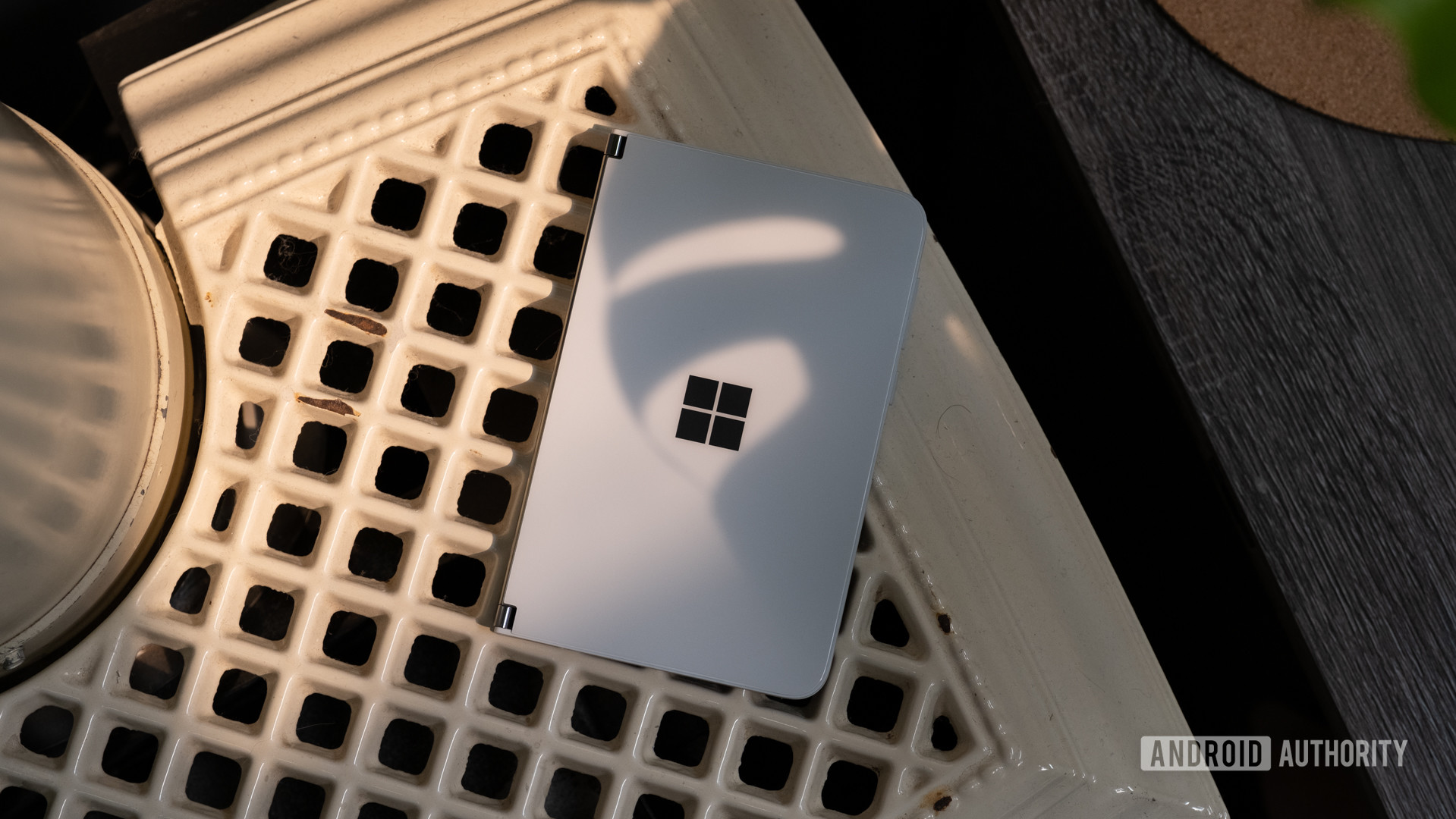
- Microsoft Surface Duo: 6GB RAM, 128GB Storage — $1,399
- Microsoft Surface Duo: 6GB RAM, 256GB Storage — $1,499
Starting at $1,399, it’s clear that Microsoft is charging a lot from the people who are willing to beta test a new form factor. The price doesn’t match the specs at all. With a Snapdragon 855, 6GB of RAM, and 128GB of storage, the Surface Duo seems much more akin to a budget flagship from last year. But the Surface Duo isn’t really about specs, it’s about form factor.
If you’re looking into a Surface Duo, you’re probably also interested in foldable phones. And there are quite a few great options available now.
If you’re willing to spend $600 more, the Samsung Galaxy Z Fold 2 is one of the best foldable phones you can buy right now. It’s much more powerful with a Qualcomm Snapdragon 865 Plus, 12GB of RAM, and 256GB of storage, and because it’s technically a third-generation foldable from Samsung, most of the kinks have already been worked out.
If you don’t want to spend the extra cash but you’re still willing to pay $1,400 for a phone, the Samsung Galaxy Z Flip and Samsung Galaxy Z Flip 5G are also great options. The devices are quite similar, but the Z Flip 5G has the Qualcomm Snapdragon 865 Plus processor with 5G connectivity, whereas the standard Z Flip has a Qualcomm Snapdragon 855 Plus. Both devices come with 8GB of RAM, 256GB of storage, and a 3,300mAh battery. The Z Flip costs $1,299.99 while the Z Flip 5G costs $1,449.99.
If you’ve decided you’re willing to live without a foldable phone but you don’t know which to get, consider checking out our Best of Android series from the first half of 2020. This should help you find the best device out of several different categories that match your needs and lifestyle.
Microsoft Surface Duo review: Should you buy it?

In its current state, I would not recommend purchasing the Microsoft Surface Duo, at least not as your main device. The Duo feels like a concept more than a product, and one that needs more refining before it’s ready for the mainstream. It’s not just that I had trouble finding appropriate use cases for two displays, it’s the fact that this device didn’t seem to behave the same way twice. I constantly found new bugs, and the general lagginess made it stressful to use.
I think Panos Panay is correct when he says the Surface Duo isn’t a phone — it doesn’t really feel like one. The Duo feels much more akin to the Microsoft Courier concept that was first incepted a decade ago — a portable tablet/booklet used as a miniature computer. But when you put it in the context of a modern smartphone the Duo feels more cumbersome than useful.
The people who will buy the Duo are Microsoft enthusiasts willing to deal with these bugs and help Microsoft improve the product over time. It’s much more niche and experimental than something like the Samsung Galaxy Z Fold 2, and you should be aware of that if you’re thinking of spending $1,400 on this device.